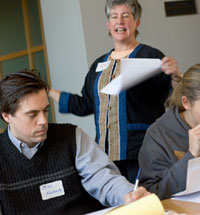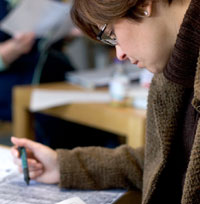|
The Program: 2006-7 Program
 Our goal for year three is to train teachers in the methods of historical inquiry (listed below) so that they can
"do history" with their students in their classroom. We plan to focus this year's workshops on modeling and practicing these methods.
Our goal for year three is to train teachers in the methods of historical inquiry (listed below) so that they can
"do history" with their students in their classroom. We plan to focus this year's workshops on modeling and practicing these methods.
Doing History Methods:
-
Generate Questions
-
Locate Sources
-
Examine
-
Interpret from Different Perspectives
-
Connect to Broad Themes
-
Draw Conclusions
-
Present Findings
EXAMPLE: Presented with copies of the 1900 and 1930 manuscript census from their town, teachers could begin by generating questions (Method 1). What countries did these people emigrate from? How have immigration patterns changed over time? What jobs did these people have? How have work patterns changed over the twentieth century?
Then teachers could be given time to examine the census and make inferences (Method 3). What do you notice? What surprises you? What inferences can you make based on this information?
Building on these observations teachers can begin the work of interpreting the data by charting the changes they see (Method 4). How many immigrants came from Italy and Ireland in 1900? How many in 1930?
 Then by placing their interpretations of the changes in work and immigration in their town next to statements made in their textbook, teachers can compare their local findings to national trends. While their textbook claims that immigrants came mostly from Eastern Europe (e.g., Italy) at the turn of the century, teachers may find that immigrants from Western Europe (e.g., Ireland) were still arriving during this period (Method 5).
Then by placing their interpretations of the changes in work and immigration in their town next to statements made in their textbook, teachers can compare their local findings to national trends. While their textbook claims that immigrants came mostly from Eastern Europe (e.g., Italy) at the turn of the century, teachers may find that immigrants from Western Europe (e.g., Ireland) were still arriving during this period (Method 5).
What could explain such a discrepancy? Here teachers are given a problem to solve. Asked to draw conclusions that make sense of their local history in national context, teachers might conclude, for example, that Irish families continued to emigrate to the northeast even as
"new immigrants" (e.g., Italian immigrants) began arriving in America. (Method 6). The work of crafting this one sentence-a sentence that summarizes their findings in a way that is interesting to people outside their community-draws on all of the skills of doing history.
Presenting this sentence for a larger audience is then the final step, where teachers get to share the results of their research and defend their conclusions (Method 7). This might take the form of an exhibit in their school or local museum or an article in the local paper.
|